
Linda Sanders’ DESERT AROUND ME Documentary Film for ADHD Awareness & Educational Outreach

Linda Sanders, founder and CEO of Hope So Bright
DESERT AROUND ME is a documentary film written and produced by Linda Sanders that uses state-of-the-art micro and macro (drone-driven) photography by Italian-based award winning director Alessandro Beltrame. Sanders is using the film as a public outreach tool and is screening it in educational, healthcare and public settings where it can provide treatment solutions that enable those diagnosed with ADHD to be productive at home, in school, and in life.
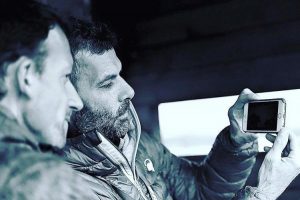
Alessandro Beltrame, director of ‘Desert Around Me’, with Team I Run 4 Ultra member Carlos Sá during filming
Sanders is interviewed in the film. She explains her journey as a parent of two learning challenged family members and why she founded her nonprofit organization, Hope So Bright, in order to help others who have been diagnosed. Healthcare providers, education specialists and athletes are also interviewed in the documentary.
Sanders has entered DESERT AROUND ME into national and international film festivals. If fortunate enough to win an award, she plans to submit her film to “Independent Lens” on PBS, and to other TV magazine and news format documentary outlets. Additionally, Sanders will be screening the film in educational, healthcare, government and corporate settings to raise awareness about ADHD.
Suited for general, social, education, sports and health-minded audiences, Sanders hopes that viewers of her film will feel moved to support her nonprofit by purchasing tickets to her Foundation’s events, making donations, volunteering, and advocating for the proper diagnosis and treatment for ADHD sufferers. The audience for this film includes those who suffer with ADHD, those who treat patients with ADHD, the education and special education community at large (pre-K through university-level) as well as any individual or organization advocating for Applied Behavioral Analysis (Cognitive Behavioral Therapy) as an alternative treatment to prescription medication.
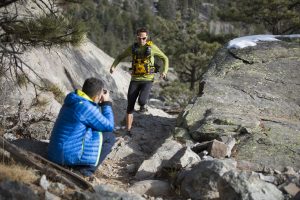
Alessandro Beltrame films Team I Run 4 Ultra member Jason Schlarb as he trains for MdS in his home state of Colorado
DESERT AROUND ME incorporates footage of the 2016 Marathon des Sables. Sanders’ IRUN4ULTRA team ran six marathons over six days across the Sahara Desert in Morocco where temperatures regularly exceeded 125 degrees Fahrenheit. Tackling endless sand dunes, burning salt flats, dried river beds and rocky slopes, the team carried all of their food and clothes, sleeping bags, cooking equipment and first aid for the entire week on their backs.
The Marathon des Sables has achieved mythical status as it tests athletes to the limit of their capabilities. The race is run in six stages. Each stage is roughly marathon distance, with the exception of the middle stage, known as the infamous double, where racers set off to complete a double marathon distance of at least 52 miles. For many, this means running through the night.

Team I Run 4 Ultra member Ricardo Mejía Hernández resting his tired and blistered feet between stages
The two main fears that the athletes face are dehydration and terrible skin-searing blisters. Water is rationed so there is only enough for drinking and no chance of washing during the six days. If one is unfortunate enough to suffer dehydration and has to be put on a drip, they incur a penalty. A drip means extra water in addition to one’s ration. Each night, as the runners passed the finish line, they inspected their feet for damage. The extreme heat burning up through their shoes, combined with sweat and sand, meant that very few escaped the trauma of agonizing blisters. Foot injuries cause the most withdrawals from the race. Runners line up to have their feet inspected, disinfected and bound by a team of doctors on duty every night, trying not to flinch at the screams and groans coming from inside the medical tent.
Runners must carry and cook their own food, carefully considering the weight to nutrition value of every meal. No one wants to wear a backpack that weighs more than 25 pounds. Every night, the runners erected goat hair tents. Each tent was shared by a mixture of eight males and females. By the end of the race, the camp looked like a scene from “The Walking Dead” as the runners hobbled to and fro on their brutalized feet, most slumped and exhausted under the shelter of their tents trying to escape the sun and recover for the next day.
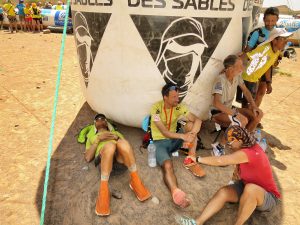
Team I Run 4 Ultra rests after one of the long stages
“We chose to participate in this race, because of its extreme nature and difficulty,” said Sanders. “We wanted to highlight the problems people face who suffer with an ADHD diagnosis, and particularly how families and children cope day after day. It takes a true hero to come through it and we hope that our Marathon des Sables team will represent the courage and tenacity that families show every day in the fight against ADHD.”
Great sporting achievements often have a gripping tale behind them. Sanders has used endurance sports as a way to capture audience attention and to tell her story. The stories that are usually the hardest to believe are the ones in the world of sports that actually happened. These true stories, like that told in DESERT AROUND ME, end up inspiring athletes and laypeople alike for generations.
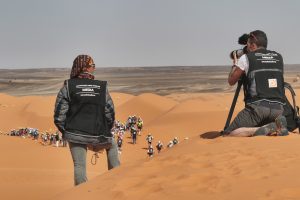
Linda Sanders and Alessandro Beltrame filming in the Sahara Desert in Morocco for the race
The panoramic or wide-angle photography in DESERT AROUND ME captures a wider perspective of the landscapes shown in the film. The elongated fields of view give the viewer a sense of scale and magnitude of the locations in which ultramarathons take place. One is immersed in the actual experience of running for a cause, with the terrain, altitude, temperature and climate challenges of the location. With an emphasis on detail, texture and pattern, Beltrame utilizes macro imaging where extreme close-ups allow the viewer to see things in a scale larger than life size.
The cinematography affects the way the viewer actually sees the events in the film. Whether they realize it or not, the way DESERT AROUND ME is filmed, where the characters are in each shot, (particularly the elite athletes), and what is shown to the viewer as opposed to what isn’t, has an emotional impact on the audience. By training the camera on athletes during an ultra marathon, the essential quality of being human is revealed. The audience is transfixed by the internal and external struggle and meaningful journey they are taking with these characters. Athletes are natural performers and draw the audience in making it difficult to take one’s eyes off of them; they invade the frame, in a tight shot, in a wide shot, and everything in between. Even when filmed in silence, the athletes tug at your heartstrings.
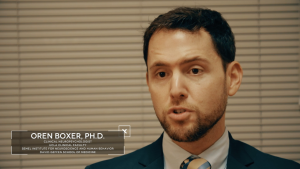
Dr. Oren Boxer, a Clinical Neuropsychologist, is interviewed for the film
Sanders provides the most compelling of interviews. Her desire to educate and help others is obvious. She is the primary champion in the documentary. The audience will admire her tenacity and maybe even question their own contributions to humanity while Sanders challenges what they know or don’t know about the world while asking them to connect more deeply to it. She comes across unselfconscious and fearless, which involves risk. Yet by being so, she teaches the audience something about life and suffering. She gives voice to the voiceless and dares to hope in the face of adversity, and like all great characters, inspires action through example. Sanders has a goal and is willing to let viewers follow her journey to reach that goal. Her life, dreams, choices and conflicts help us articulate something about the larger world. These elements keep the audience alert, thinking and engaged with what is at stake as they watch DESERT AROUND ME.
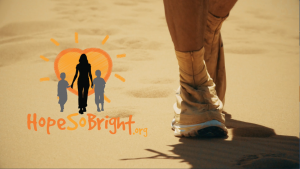
An still frame from the film
The film’s aesthetic and visual palette largely determines its mood, feel and theme. The better a film looks, the more exciting it is to the eye, and the more memorable and stimulating. The intense color saturation of imagery throughout DESERT AROUND ME is breathtaking. The different qualities of light are apparent in the various locations where the film is shot and beautifully displays the changing of the seasons throughout the year while serving as a metaphor for transformation.
The ebb and flow of the film’s soundtrack melds with its images. While the music score has more of a subliminal importance, the sound is not distracting to the audience, but yet complimentary and noticeable. The ambience of the music subconsciously tells the viewer how to feel. Each scene’s weight, scale, and importance is supported by sound. Knowing how to complement the visual shape of a documentary film with the auditory shape of its soundtrack is apparent in DESERT AROUND ME. Large objects are accompanied by bass; small objects are highlighted with delicate, more intricate sounds. Fast movement is accompanied by quick tempos. To get the audience’s attention, amplified sounds are used, while muted tones allow for contemplation. There are also pauses throughout the documentary that allow for natural sounds to take center stage.
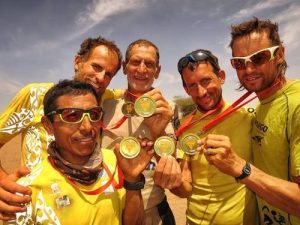
Team I Run 4 Ultra flashing their second-place medals!
The viewer can connect with the characters shown in the film and really feel what writer Sanders intended them to feel: the full range of emotions, yet ultimately, inspired, called to action, informed and hopeful. As American director, Elia Kazan once remarked, “…after a film, you should be changed in some way.”
The film is simple, honest, and delivered with passion, mirroring the things that make films so great. It leaves the viewer with the message that if you put your effort and concentration into playing to your potential, to being the best sportsperson that you can be, you will triumph and be a winner. Or, as Sanders says, a “hero.” DESERT AROUND ME shows, that while life is often unfair, we all have the power within us to shape our own destiny by the choices we make and that there is always hope.
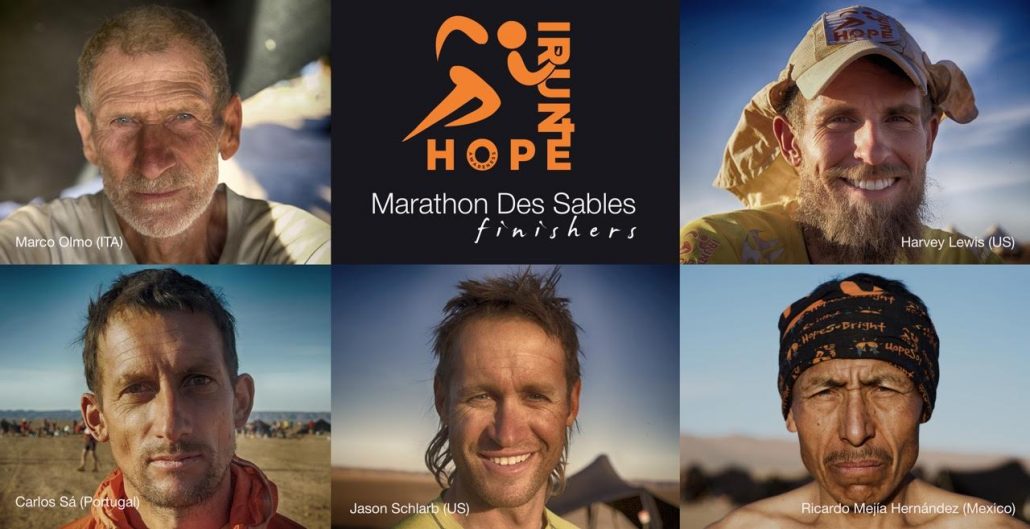
*THIS FILM IS AVAILABLE


